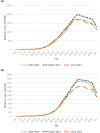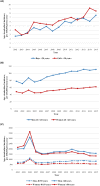Secular trends in incidence of type 1 and type 2 diabetes in Hong Kong: A retrospective cohort study
- PMID: 32078650
- PMCID: PMC7032690
- DOI: 10.1371/journal.pmed.1003052
Secular trends in incidence of type 1 and type 2 diabetes in Hong Kong: A retrospective cohort study
Abstract
Background: There is very limited data on the time trend of diabetes incidence in Asia. Using population-level data, we report the secular trend of the incidence of type 1 and type 2 diabetes in Hong Kong between 2002 and 2015.
Methods and findings: The Hong Kong Diabetes Surveillance Database hosts clinical information on people with diabetes receiving care under the Hong Kong Hospital Authority, a statutory body that governs all public hospitals and clinics. Sex-specific incidence rates were standardised to the age structure of the World Health Organization population. Joinpoint regression analysis was used to describe incidence trends. A total of 562,022 cases of incident diabetes (type 1 diabetes [n = 2,426]: mean age at diagnosis is 32.5 years, 48.4% men; type 2 diabetes [n = 559,596]: mean age at diagnosis is 61.8 years, 51.9% men) were included. Among people aged <20 years, incidence of both type 1 and type 2 diabetes increased. For type 1 diabetes, the incidence increased from 3.5 (95% CI 2.2-4.9) to 5.3 (95% CI 3.4-7.1) per 100,000 person-years (average annual percentage change [AAPC] 3.6% [95% CI 0.2-7.1], p < 0.05) in boys and from 4.3 (95% CI 2.7-5.8) to 6.4 (95% CI 4.3-8.4) per 100,000 person-years (AAPC 4.7% [95% CI 1.7-7.7], p < 0.05] in girls; for type 2 diabetes, the incidence increased from 4.6 (95% CI 3.2-6.0) to 7.5 (95% CI 5.5-9.6) per 100,000 person-years (AAPC 5.9% [95% CI 3.4-8.5], p < 0.05) in boys and from 5.9 (95% CI 4.3-7.6) to 8.5 (95% CI 6.2-10.8) per 100,000 person-years (AAPC 4.8% [95% CI 2.7-7.0], p < 0.05) in girls. In people aged 20 to <40 years, incidence of type 1 diabetes remained stable, but incidence of type 2 diabetes increased over time from 75.4 (95% CI 70.1-80.7) to 110.8 (95% CI 104.1-117.5) per 100,000 person-years (AAPC 4.2% [95% CI 3.1-5.3], p < 0.05) in men and from 45.0 (95% CI 41.4-48.6) to 62.1 (95% CI 57.8-66.3) per 100,000 person-years (AAPC 3.3% [95% CI 2.3-4.2], p < 0.05) in women. In people aged 40 to <60 years, incidence of type 2 diabetes increased until 2011/2012 and then flattened. In people aged ≥60 years, incidence was stable in men and declined in women after 2011. No trend was identified in the incidence of type 1 diabetes in people aged ≥20 years. The present study is limited by its reliance on electronic medical records for identification of people with diabetes, which may result in incomplete capture of diabetes cases. The differentiation of type 1 and type 2 diabetes was based on an algorithm subject to potential misclassification.
Conclusions: There was an increase in incidence of type 2 diabetes in people aged <40 years and stabilisation in people aged ≥40 years. Incidence of type 1 diabetes continued to climb in people aged <20 years but remained constant in other age groups.
Conflict of interest statement
RCWM acknowledges receiving research support (outside of this work) from AstraZeneca, Bayer, Pfizer for conducting clinical trials and honoraria or consultancy fees from AstraZeneca and Boehringer Ingelheim, all of which has been donated to the Chinese University of Hong Kong to support diabetes research. RCWM is a member of the Editorial Board of PLoS Medicine. AOYL acknowledges receiving research support (outside of this work) from Boehringer Ingelheim, MSD, Sanofi, Amgen and travel grants from travel grant from AstraZeneca, Boehringer Ingelheim, MSD, Novartis, Novo Nordisk, Sanofi. JCNC and RCWM are cofounders of GemVCare, a diabetes genetic testing laboratory, which was established through support from the Technology Start-up Support Scheme for Universities (TSSSU) from the Hong Kong Government Innovation and Technology Commission (ITC).
Figures


References
-
- International Diabetes Federation. IDF Diabetes Atlas. 8th ed Brussels, Belgium: International Diabetes Federation; 2017.
-
- Census and Statistic Department. Thematic Household Survey Report No. 50. Hong Kong SAR: Census and Statistics Department; 2013 [cited 2019 Oct 18]. https://www.statistics.gov.hk/pub/B11302502013XXXXB0100.pdf
MeSH terms
LinkOut - more resources
Full Text Sources
Medical

